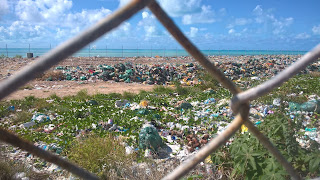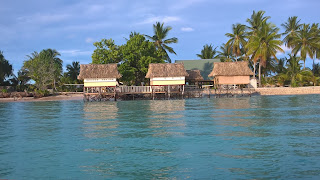Reflections G-M
G is for Garbage: Okay, so I mean rubbish but was struggling with a G word so have borrowed the American equivalent. Rubbish is a major problem out here, there is a weekly rubbish pick up but a lot more recycling and separation needs to be done. The landfills are pretty full and are squeezed into the little land available that backs onto the lagoon. There is not much land available to dump excess rubbish and a some of it ends up on the street, beaches, in the lagoon and ocean. There are occasional clean ups of different beaches etc and there are a number of people working here to improve waste management systems but more needs to be done, to curb the rubbish problem.
 |
| Landfill |
 |
| Landfill squeezed in between the lagoon and ocean |
A lot of litter ends up in the lagoon and on the beaches. For international volunteers day the various New Zealand, Australian, Japanese and German volunteers gathered with the local community at Taboraio to clean up the causeway at Taborio, both picking up rubbish and planting mangroves to protect the beaches. We picked up about 600kg of rubbish in two hours! But it was literally a drop in the bucket when it comes to the amount of crap that litters what must have once been the pristine beaches of South Tarawa.
H is for Housing: Most people’s houses are extremely basic, four tin walls and a roof held down by concrete blocks being common. Traditional houses, kiakia are built to make the most of the sea breezes, well ventilated and the woven bandanas palm rooves keep them cool but modern homes, thrown together from whatever materials are at hand are the opposite. Is there a less suitable material for on a hot island surrounded by ocean than corrugated iron? The sun beats down on it and intensifies the heat and it rusts, damn quickly out here. Can’t think of anything less suited as a building materials but it seems to be the main one.
 |
| A home near my place in Antenon- we don't get cyclones or strong winds here at the equator a good thing ereally when you look at the rooves! |
 |
| Housing on Betio- the most densely populated place in the Pacific- pop density more than London or Hong Kong! |
I-matung: Foreigners are known as i-Matung. We are treated with respect and courtesy where ever we go. Whether travelling though one of the remote villages in the outer islands or simply biking along the main road to get some groceries you are always greeting by smiling kids wanting a high five or simply to say “Mauri i-matung” (hello foreigner). There aren’t that many of us out here and we do get a lot of respect from the locals so it’s been a really nice experience to be acknowledged simply for walking down the road by the local kids. If you are having a bit of a rough day the kids soon get you in a better mood.
Japanese Vols: There there are a about 10 Japanese volunteers working on South Tarawa, along with the ten or o of us kiwis an Aussies. The Japanese volunteers roles include a doctor, a table tennis coach, an engineer, a Japanese Language instructor at MTC where I work, a midwife and a waste management expert. The J-Vols usually sign on for two years at a time and like the rest of us are doing their bit to try and improve things at a local level in the various organisations and institutions that they work.
 |
| Japanese volunteers and local community at international volunteer day beach clean up. |
I do enjoy throwing words of my barely remembered Japanese into conversations with the Japanese volunteers and making my own form of pidgin Jap-lish.
K is for Kiribati. Small, isolated, miles from nowhere, the back of beyond, far side of the black stump. Call it what you want but like New Zealand Kiribati is adversely affected by the tyranny of distance and geographic isolation. Almost all foods stuffs and other goods are imported into South Tarawa. The islands that cling to the edge of Tarawa lagoon barely a forty of fifty metres across in many places and barely a mater above sea level yet life has thrived out here for centuries. The people are warm, friendly and have their own wonderful vibrant culture and outlook on life. Being out here isn’t like stepping back in time but it is a window in to a world that is rapidly changing as are the lifestyles of the inhabitants. Most of the young people have cellphones, the internet and mobile connectivity continues to improve, while there are more and more cars on the road (which for most of the islands of South Tarawa is a single road), not to mentioned stripped out rusting wrecks on the side of it.
The people face some awful stats when it comes to life expectancy, infantry mortality rates, domestic violence etc. One recent survey had 50% of the population suffering form type 2 diabetes due in no small part to the local diet!
Even so there is a unique, vibrant and caring society at the heart of everything. The islands, as is true everywhere, are undergoing rapid change and face some unique hurdles but there is a positivity about life out here. The way of life is different to anywhere else ’experienced, maybe the way of living is simpler, the ebb and flow of the day is still very much influenced by the tides for many people, just as it has been for centuries. Life still very much seems to be attuned, especially on North Tarawa and the outer islands, to nature that we could all learn from that. People here live with nature rather than trying to bend it to their will as we in the west are wont to do. I feel lucky to have had the opportunity to witness first hand a country at a bit of a crossroads. Will things improve for the people or will the challenges the country face overwhelm them? I’d like to think the former.
 |
| Local i-Kiribati helping to plant Mangroves on volunteer day |
L is for lagoon: Tarawa lagoon is about 500km2. It is big. The atolls and islets form a ribbon clinging to the circumference of this giant fish bowl. On the South Tarawa side it is polluted with extremely high e-coli readings so us i-Matung do not swim in it but the locals do use it for fishing, swimming, their daily wash and to go to the toilet. There have been some NZ medical personal doing a study on ear health out here and they found 90% of the kids they tested had hearing loss and hearing issues which were attributed to swimming/bathing in the lagoon so are procuring funding to put some aural health programmes in place across South Tarawa.
 |
| At the end of the day families bath in the lagoon and kids enjoy swimming |
 |
| The Nippon causeway inhibits the natural flow of water, helping create the cesspool that is water quality on South Tarawa. |
North Tarawa is a complete contrast to south. The water is flows through the channels between the islets each day and so is clean and swimmable so is our preferred place to go swimming. It really is a different world up there, unspoilt sandy beaches, a true Pacific paradise.
 |
| North Tarawa |
 |
| Morning muster- 7:50am every morning. |
 |
| New classrooms built with money from NZ |
What did shock me was when I first started and was interviewing the potential students for one of the programmes at least 1/3 of those I interviewed had lost one or both parents. We are talking young people from 18-22 years average. Back home, you’d have half the kids parents divorced or separated and might have one or two who’d lost a parents, but not 1/3 or more out of 80 or 90 people i interviewed. That really hit home to me how hard life is, and how low the life expectancy is, for people out here.
 |
| Another view towards the new classrooms |
It has been a real privilege to have had the opportunity to work here as a volunteer for a year and I will miss it.
Mum- I guess when I came out here I was expecting a lot of challenges and pushing myself outside my comfort zone but what I wasn’t expecting, even though her health hadn’t been good for the past few years, was losing my mother. It was a real blow to all the family but being out here, isolated and far away and not even being able to talk to them whilst they were all able to get to see mum in hospital and say their goodbyes in person, was probably the hardest part of the whole experience this year for me. I received a text message from my wife to tell me my mother had just passed away as I was unable to contact them directly via phone. That was hard.
I know I struggled out here for the next couple of months as I dealt with the grief but am grateful for the way in which VSA and MTC both helped out and made getting home so easy. It was probably the defining experience of my time here in many ways.








Comments
Post a Comment